KILLER BACK AND BICEPS WORKOUT
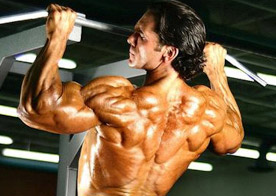
Training back and biceps together is a common bodybuilding strategy since both are “pulling” muscle groups and work together to perform various exercises.
Any time you perform a compound back exercise such as a chin-up, pulldown or row, both the back muscles and the biceps will be engaged in the movement. By training these muscles on the same day, it maximizes recovery by preventing overlap throughout the week.
What is the best way to structure an effective back and biceps workout?
Let’s cover it step by step, starting with your back.
At the end of the article I’ll bring everything together by laying out a step-by-step plan that you can follow.
How To Effectively Train Your Back
Your back consists of a very large group of individual muscles, each with their own unique functions.
The major groups to pay attention to here are the lats, traps, rhomboids, teres groups, and spinal erectors.
In order to fully stimulate all of these individual muscles, you’re going to want to perform 4 separate exercises…
#1 – Deadlifts
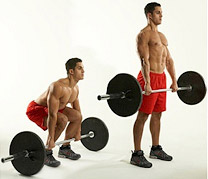
Deadlifts will hammer your entire back from top to bottom with specific emphasis on the traps, spinal erectors and lower back muscles. In fact, deadlifts are probably the most powerful mass builder out there not just for your back, but for your entire body as a whole.
Give your deadlifts priority by placing them first in your routine, with 2-4 sets of 5-7 reps per set.
#2 – Vertical Pull
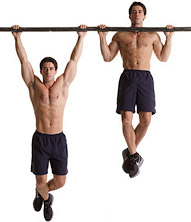
A vertical pulling movement is used to target the lats for overall back width and is performed by either pulling your body weight upward (chin ups/pull ups) or pulling resistance downward (lat pulldowns).
After your deadlifts are complete, select one of the following vertical pulling movements…
* Wide-grip overhand chin-ups
* Wide-grip overhand lat pulldowns
* Close-grip underhand chin-ups
* Close-grip underhand lat pulldowns
* V-bar pulldowns
Select that one that allows you to target your lats most effectively, though the overhand variations tend to be more effective since they limit bicep involvement.
Perform 2-4 sets of your vertical pulling movement for 5-7 reps.
#3 – Horizontal Pull
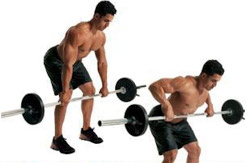
Next up is a horizontal pulling movement, otherwise known as “rows”. These also target the lats but also put emphasis on the mid-back muscles for overall back thickness.
Select one of the following horizontal movements and perform them after your vertical pulling movement…
* Bent over barbell rows
* Bent over dumbbell rows
* One-arm dumbbell rows
* T-bar rows
* Seated cable rows
Again, the one you select will come down to personal preference, but choose one of the free weight variations whenever possible. I would only recommend the machine variations if you have a lower back injury.
Perform 2-4 sets of your horizontal pulling movement for 5-7 reps.
#4 – Shrug
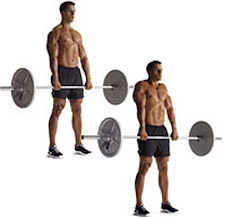
To finish off your back workout, you’ll want to perform a shrugging movement to target your upper traps.
Any of the following 4 variations are fine…
* Barbell shrugs
* Dumbbell shrugs
* Smith machine shrugs
* Cable shrugs
Perform 2-3 sets of your shrugging exercise for 8-10 reps.
How To Effectively Train Your Biceps

After you’ve completed your back workout, your biceps will have already been heavily stimulated.
Remember, any time you perform a compound vertical pulling or horizontal pulling exercise for your back, your biceps are also engaged in the exercise.
For that reason, your biceps don’t really require a lot of direct work.
The biceps perform the function of elbow flexion and elbow supination, and you’ll want to include 2 separate exercises in your routine with 1 to target each movement pattern.
The first will be a standard palms up curl.
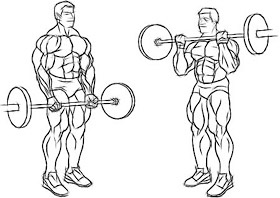
This is a pure elbow flexion exercise and you can select either a barbell curl or standing cable curl for this movement. Perform 2-3 sets of 5-7 reps.
The second will be a supinating dumbbell curl.
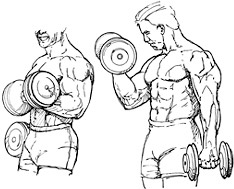
This is a supination exercise (where the hand “twists” from neutral to palms up as the weight is curled) and I would recommend going with a basic standing alternating dumbbell curl. Perform 2-3 sets of 5-7 reps.
Your Complete Back And Biceps Workout
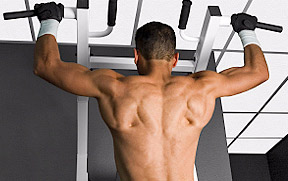
When it comes to structuring an effective back and biceps workout for overall muscle size and strength gains, that’s really all you’re going to need: a deadlift, vertical pull, horizontal pull, shrug, palms up curl and supinating curl.
Let’s now put it all together with 3 sample routines that follow these guidelines. Select whichever one you prefer, as they’ll all be highly effective…
Back And Biceps Workout #1
|
Exercise
|
Sets
|
Reps
|
|
Deadlifts
|
2 – 4
|
5 – 7
|
|
Overhand Wide-Grip Chin Ups
|
2 – 4
|
5 – 7
|
|
One-Arm Dumbbell Row
|
2 – 4
|
5 – 7
|
|
Barbell Shrugs
|
2 – 4
|
8 – 10
|
|
Barbell Curl
|
2 – 3
|
5 – 7
|
|
Alternating Dumbbell Curl
|
2 – 3
|
5 – 7
|
Back And Biceps Workout #2
|
Exercise
|
Sets
|
Reps
|
|
Deadlifts
|
2 – 4
|
5 – 7
|
|
V-Bar Pulldown
|
2 – 4
|
5 – 7
|
|
Bent Over Dumbbell Row
|
2 – 4
|
5 – 7
|
|
Dumbbell Shrugs
|
2 – 4
|
8 – 10
|
|
Cable Curl
|
2 – 3
|
5 – 7
|
|
Alternating Dumbbell Curl
|
2 – 3
|
5 – 7
|
Back And Biceps Workout #3
|
Exercise
|
Sets
|
Reps
|
|
Deadlifts
|
2 – 4
|
5 – 7
|
|
Underhand Pulldowns
|
2 – 4
|
5 – 7
|
|
Bent Over Barbell Row
|
2 – 4
|
5 – 7
|
|
Smith Machine Shrugs
|
2 – 4
|
8 – 10
|
|
Barbell Curl
|
2 – 4
|
5 – 7
|
|
Alternating Dumbbell Curl
|
2 – 4
|
5 – 7
|
Here are a few more important things to keep in mind…
1) The number of sets you perform per exercise (whether it’s 2, 3 or 4) will depend on your training intensity level. If you’re training to all out failure on every set, then 2 will be fine, and if you’re training with more moderate intensity, go with 3-4.
2) Make sure to write down every workout in a training journal and strive to continually add more weight to each exercise over time.
3) I would recommend using a set of lifting straps for all of your back exercises as it will eliminate your grip from the equation and allow you to focus more directly on your back muscles.
– Sean
Here’s what to do next…
If you found this article helpful, make sure to sign up for your FREE custom fitness plan below...




